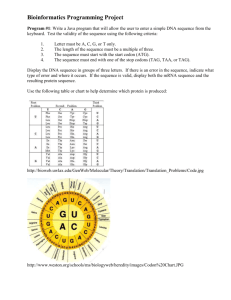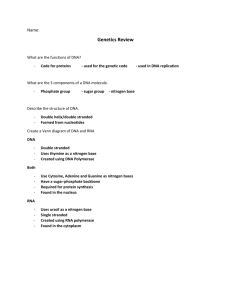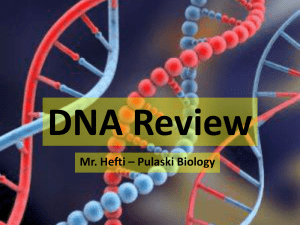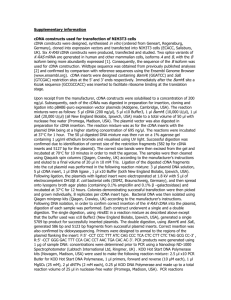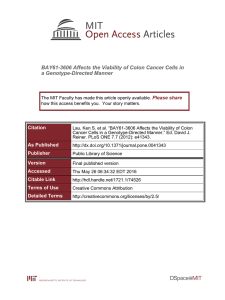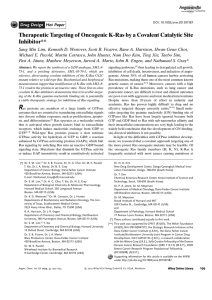DETAILED MATERIALS AND METHODS
advertisement
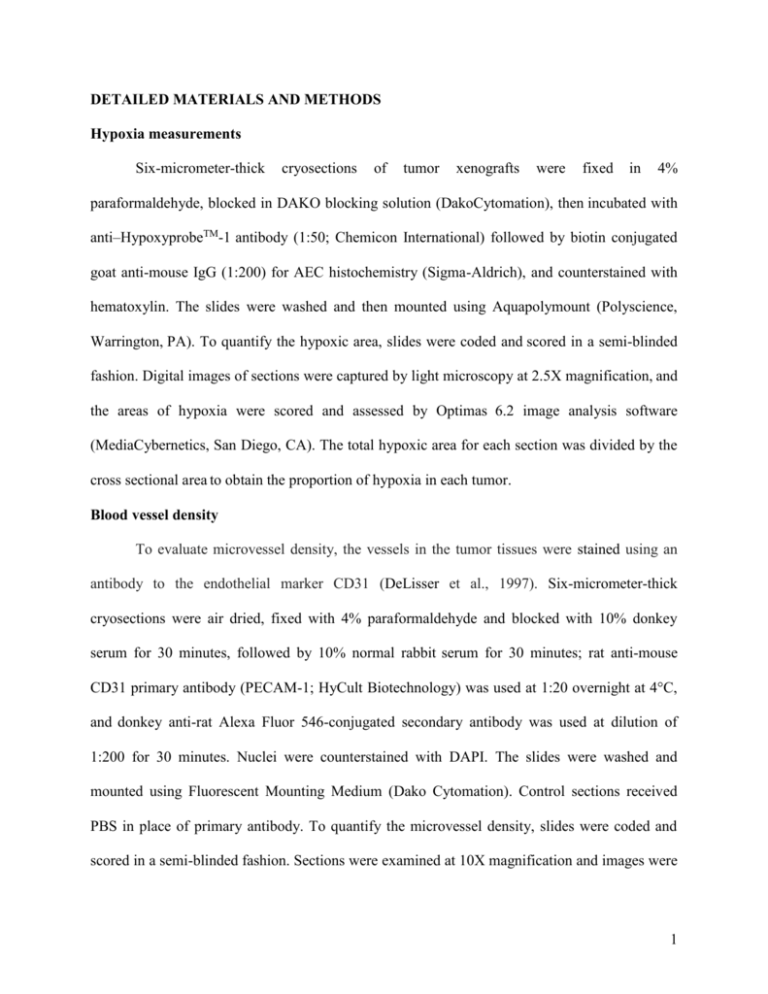
DETAILED MATERIALS AND METHODS Hypoxia measurements Six-micrometer-thick cryosections of tumor xenografts were fixed in 4% paraformaldehyde, blocked in DAKO blocking solution (DakoCytomation), then incubated with anti–HypoxyprobeTM-1 antibody (1:50; Chemicon International) followed by biotin conjugated goat anti-mouse IgG (1:200) for AEC histochemistry (Sigma-Aldrich), and counterstained with hematoxylin. The slides were washed and then mounted using Aquapolymount (Polyscience, Warrington, PA). To quantify the hypoxic area, slides were coded and scored in a semi-blinded fashion. Digital images of sections were captured by light microscopy at 2.5X magnification, and the areas of hypoxia were scored and assessed by Optimas 6.2 image analysis software (MediaCybernetics, San Diego, CA). The total hypoxic area for each section was divided by the cross sectional area to obtain the proportion of hypoxia in each tumor. Blood vessel density To evaluate microvessel density, the vessels in the tumor tissues were stained using an antibody to the endothelial marker CD31 (DeLisser et al., 1997). Six-micrometer-thick cryosections were air dried, fixed with 4% paraformaldehyde and blocked with 10% donkey serum for 30 minutes, followed by 10% normal rabbit serum for 30 minutes; rat anti-mouse CD31 primary antibody (PECAM-1; HyCult Biotechnology) was used at 1:20 overnight at 4°C, and donkey anti-rat Alexa Fluor 546-conjugated secondary antibody was used at dilution of 1:200 for 30 minutes. Nuclei were counterstained with DAPI. The slides were washed and mounted using Fluorescent Mounting Medium (Dako Cytomation). Control sections received PBS in place of primary antibody. To quantify the microvessel density, slides were coded and scored in a semi-blinded fashion. Sections were examined at 10X magnification and images were 1 captured using a Leica Opti-Tech epifluorescence microscope equipped with appropriate excitation and emission filters. The total number of blood vessels for each section was divided by the cross-sectional area to obtain the microvessel density (MVD; # blood vessels per mm2). Cell sorting To demonstrate the direct involvement of hypoxia on K-ras mutation of these tumor cells, we used our previously reported approach to sort cells from Dks-8 xenografts based on their proximity to perfused blood vessels (Herman et al., 1989; Yu et al., 2002). Briefly, the cells most proximal to perfused vessels were labeled by cardiac injection of 0.25 mg/mouse Hoechst 33342 dye, in 200 µl volume, five minutes before euthanasia; mice had previously been injected with Hypoxyprobe as described in Materials and Methods of main manuscript. This procedure yields highly fluorescent cells immediately surrounding the vasculature and low fluorescence intensity in more distal, unperfused areas (Herman et al., 1989; Yu et al., 2002). After enzymatic disaggregation of each Dks-8 xenograft into a single-cell suspension, samples were fixed in 10% formalin for 5 min, washed with PBS and sorted by fluorescence-activated cell sorting (using a 350-70nm UV channel with a FACSVantageSE™ instrument), and the cells displaying the 5% highest (“Bright”) and 5% lowest (“Dim”) Hoechst fluorescence intensities were collected. Five Dks-8 xenografts were used for this part of the study. Cell suspensions containing 500 cells from “Bright” and “Dim” sorted populations were used to generate cytospin slides, which were air-dried at room temperature (RT) for 15 minutes, washed and blocked with 4% normal goat serum plus 2% bovine serum albumin (BSA) in PBS at RT for 30 min. This was followed by incubation in Dako Protein block (Dako) for 15 min. Slides were then incubated for one hour with anti-HypoxyprobeTM-1 antibody (Chemicon International Corp.) and washed in PBS, followed by 30 min incubation with Secondary antibody (anti-mouse 2 Cy3). The slides were washed and mounted using Fluorescent Mounting Medium (DakoCytomation). Images were captured using objective 20X of a Leica Opti-Tech epifluorescence microscope equipped with appropriate excitation and emission filters. Images were merged using Adobe Photoshop 5.0 (Adobe). Control sections received PBS in place of primary antibody. Remaining sorted cells were pelleted and their DNA was extracted for K-ras mutation analysis as described below. K-ras mutation analysis DNA from DLD-1 cells (which are heterozygously mutated in codon 13 (Shirasawa et al., 1993)) was used as a positive control for codon 13 K-ras mutation. DNA was extracted from cultured cells and xenografted tissues using a DNeasy Tissue Kit from QIAGEN Inc. (ON, Canada). K–rasG13D mutations were determined using a PCR-RFLP analysis with the restriction enzyme XcmI as described previously (Shahrzad et al., 2005). Briefly, ten µL of the PCR reaction was digested with XcmI (10 U; New England Biolabs) for 20 hours at 37 °C, in a total volume of 40 µL. When codon 13 is wild-type, the PCR product (165 bp) contains a restriction site for XcmI, and digestion yields bands of 137 and 28 bp. If there is a mutation in either of the first two bases of codon 13, the mutant PCR fragment will not be cut by XcmI, and will remain at its original size of 165 bp. Digested products were visualized by electrophoresis on a 3% agarose gel (containing 0.3 g/ml ethidium bromide). To enhance the 165 bp products, which represent the mutated DNA, a second PCR-RFLP using the products of the first digestion as templates was performed. The same primers from the first PCR could thus more selectively amplify the undigested mutated DNA from the first digestion. Thus, a two-step PCR-RFLP led to selectively amplification of the mutated K-ras, which was confirmed and identified by sequencing. The bands corresponding to DNA fragments of length 165 bp, indicating undigested mutated DNA, 3 were excised from 3% agarose gels and purified using a Qiagen QIAquick™ Gel Extraction Kit (ON, Canada) before sequencing using an ABI Prism™ Big Dye® Terminator Cycle Sequencing Ready Reaction Kit. Automated sequencing using ABI DNA sequencers was conducted at the Guelph Molecular Supercentre at the University of Guelph, Guelph, ON, Canada. Similar PCR-RFLP approaches (Shahrzad et al. 2005; modified from Toyooka et al., 2003) were used to examine K-ras mutations at codon 61 in the xenografts (Supplementary Fig. 1). K-ras codon 61 letter 1 and 2 mutations were determined by a two-step PCR-RFLP analysis. The PCR amplification produces a 271 bp fragment, which was digested with Bcl I. The digestion products of the wild-type DNA are 25 bp and 246 bp fragments. The mutant DNA will remain 271 bp. A second PCR was performed to amplify the undigested mutant DNA and a second digestion was then completed on the new PCR DNA. K-ras codon 61 letter 3 mutations were determined by a single-step PCR-RFLP (Shahrzad et al. 2005; modified from Toyooka et al., 2003). The PCR product of 229 bp was digested with Bsp H1 or DraIII. Bsp H1 will cut if the third letter in the codon is mutated from an A to a T, leading to fragments of 27 and 202 bp, and Dra III will cut if the third letter is mutated from A to C leading to fragments of 26 bp and 203 bp. A second PCR cannot be performed to enhance any mutated PCR product due to the cleavage of the mutant DNA. ADDITIONAL EXPERIMENTS In vitro oxygen and glucose deprivation To test whether ischemic conditions of tumor microenvironment can affect nongenetically engineered cells, the parental cell line of Dks-8 cells (DLD-1) and CRC HCT116 cell line, which both have one K-ras codon 13 allele mutated (Shirasawa et al., 1993) were exposed 4 to ischemic conditions in vitro. Cells were maintained in standard culture conditions: DMEM (Sigma-Aldrich, Oakville, ON, Canada) supplemented with 10% heat-inactivated fetal bovine serum, 50 µg/mL gentamicin, 1 mmol/L sodium pyruvate, and 5 µL/mL of Fungizone antimycotic, at 37°C in a humidified atmosphere containing 5% CO2. Glucose deprivation was performed by substituting normal DMEM (1000 mg/L) with glucose-free DMEM (SigmaAldrich). Hypoxic conditions were achieved using a Modular Incubator Chamber (BillupsRothenberg, Inc., Del Mar, CA) modified to permit continuous flushing of the chamber with a humidified mixture of 95% N2 and 5% CO2; the oxygen content in the chamber was kept at <0.1% in all hypoxia experiments. 2 x 106 cells were seeded into 100 mm plates, which were incubated under normal cell culture conditions overnight. Thereafter, the plates were assigned to one of two groups—control and hypoglycemia plus hypoxia—and exposed to these conditions for 24 or 48 hours. The cells were then harvested and tested for K-ras mutation. Each experiment was repeated three times in duplicates. There was an enrichment in the amount of K-ras mutation at codon 13 in the ischemia exposed HCT116 and DLD-1 cells (Supplementary Fig. 2). When the same cells are grown as xenografts, the enrichment of additional K-ras mutations is even greater (Shahrzad et al., 2005). These results thus demonstrate that two independent human CRC cell lines, with different underlying mutation spectra (e.g. p53 status) can develop additional Kras mutations under appropriate conditions, and hence the results we report in this manuscript are applicable to non-genetically engineered cells. 5 SUPPLEMENTARY FIGURE LEGENDS SF1: A) Two-step PCR-RFLP analysis of DNA from Dks-8 xenografts of LDM cyclophosphamide treated mice (T) versus control mice (C) was used to detect K-ras mutations for letter 1 and/or 2 at codon 61. Wild-type and mutant DNA produce a 246 bp and a 271 bp product after digestion by Bcl I, respectively. All 10 treated and control tumors were wild-type for letter 1 and/or 2 at codon 61 (5 examples are shown here). An undigested PCR product was used to show the position of a mutant band on the gel. B) One-step PCR-RFLP analysis of DNA from Dks-8 xenografts of LDM cyclophosphamide treated mice (T) versus control mice (C) was used to detect K-ras mutations for letter 3 at codon 61. For the third letter of K-ras codon 61, wild-type sequence remains uncut with a size of 229 bp and mutant DNA is digested by Bsp H1 and Dra III to produce fragments of 202 and 203 bp for point mutations of A to T and A to C, respectively. All 10 treated and control tumors were wild-type for letter 3 at codon 61 (2 examples are shown here); DLD-1 and Dks-8 cell lines are used as known K-ras codon 61 wildtype controls for these experiments. SF2: K-ras status of DLD-1 and HCT116 cells exposed to low oxygen and low glucose (LOLG) in vitro for 24 and 48h. DNA from Dks-8 cells was used as negative control. In all gels, larger fragments (165 bp) represent mutated K-ras codon, and smaller fragments (137 bp) represent wild-type. Below each gel are values from densitometry quantification of the proportion of mutant K-ras codon 13. There was enrichment in the amount of K-ras mutation in LOLG exposed HCT116 and DLD-1 cells. 6




